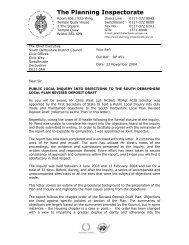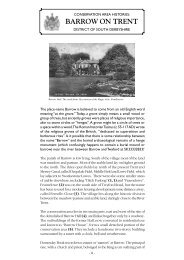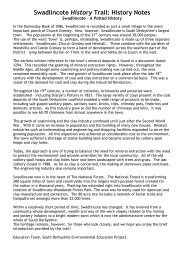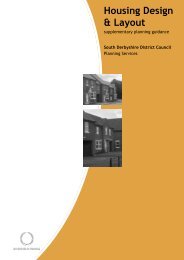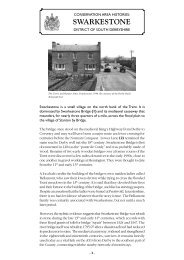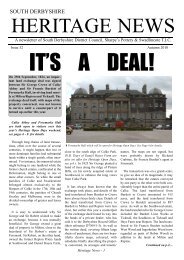Heritage News 19 - South Derbyshire District Council
Heritage News 19 - South Derbyshire District Council
Heritage News 19 - South Derbyshire District Council
You also want an ePaper? Increase the reach of your titles
YUMPU automatically turns print PDFs into web optimized ePapers that Google loves.
REJECTED!<br />
Some would-be listed<br />
buildings that didn’t<br />
make it...<br />
head is an individual structure and is not of sufficient<br />
architectural or historic interest to merit listing.”<br />
Beehive Kiln, Hepworth’s, Swadlincote<br />
Requests to have buildings “listed” are sometimes<br />
rejected even when the <strong>District</strong> <strong>Council</strong> has<br />
considered that there have been good grounds for<br />
listing them. Examples include:<br />
65, Main Street, King’s Newton.<br />
•A Cruck Truss at 65, Main Street<br />
An unspoilt cruckframed<br />
cottage<br />
between two<br />
h e a v i l y<br />
modernised<br />
properties. The two<br />
cruck frames, wellpreserved<br />
and<br />
p o s s i b l y<br />
mediaeval, are<br />
good examples.<br />
This is the only<br />
known example of<br />
a cruck-framed<br />
building in <strong>South</strong><br />
<strong>Derbyshire</strong> which is not a listed building. Nevertheless,<br />
the Department for Culture, Media and Sport declined<br />
to list this building in <strong>19</strong>99, saying it was part of a terrace<br />
of cottages, disqualified for listing by the heavy<br />
alterations to the other properties in the row.<br />
Wellhead, Top Farm, Ticknall.<br />
•The well head near Top Farm,<br />
Ticknall, built in 1871.<br />
This wellhead, restored a<br />
few years ago by the<br />
Ticknall Preservation and<br />
Historical Society, was<br />
built in 1871, preceding<br />
the well-known, greenpainted,<br />
cast iron “taps”<br />
of <strong>19</strong>14 that are so much<br />
a feature of the village.<br />
English <strong>Heritage</strong>, via the<br />
Department for Culture,<br />
Media and Sport, has<br />
been approached twice<br />
with a request to list this<br />
building, but has declined<br />
to list it on both<br />
occasions. They say “It does not contain a pump and<br />
was not part of the installation of the listed pump system<br />
in <strong>19</strong>14. English <strong>Heritage</strong> have concluded that the well-<br />
This is the last remaining downdraught or “beehive” kiln<br />
in the Swadlincote area, which once had score upon<br />
score of them. Used for firing bricks and pipes etc.,<br />
modern technology and the decline of the local clay<br />
industry has accounted for their destruction. This final<br />
example, albeit in a very poor condition, had therefore<br />
become valuable.<br />
Nevertheless, English <strong>Heritage</strong> via the Department for<br />
Culture, Media and Sport considered that it was unworthy<br />
of listing on its own. They said: “The kiln is of<br />
indeterminate date, since the nature of the industrial<br />
process results in a continuous rebuilding programme<br />
as kiln linings deteriorate. Much of the surviving fabric<br />
is probably of the late 20 th century, while its design is<br />
representative of the technology of the late <strong>19</strong> th century.<br />
Its associated chimney is listed, but the kiln is now an<br />
isolated component in a much altered surrounding area.<br />
English <strong>Heritage</strong> have concluded that the building is not<br />
of sufficient architectural or historic interest to merit<br />
listing.”<br />
Consent has been given for the demolition of the kiln,<br />
subject to detailed prior recording for posterity, as part<br />
of the scheme for the new Morrison’s Supermarket.<br />
Steam Mill, Smisby<br />
This building is completely unremarkable on the outside,<br />
but the interior contains conventional mill machinery for<br />
grinding oats, barley and wheat, powered by steam<br />
instead of wind or water. The machinery was apparently<br />
installed within the shell of an earlier farm building at<br />
some point in the <strong>19</strong> th century. The machinery is crudely<br />
put together and assembled using a jumble of materials,<br />
including an old wooden two-holer privy seat!<br />
Unfortunately, English <strong>Heritage</strong> deemed it to be too<br />
rustic, makeshift and crude for listing.<br />
<strong>Heritage</strong> <strong>News</strong> - 9<br />
•Firing a beehive kiln, from the Donisthorpe<br />
Colliery Co’s brochure <strong>19</strong>51.




